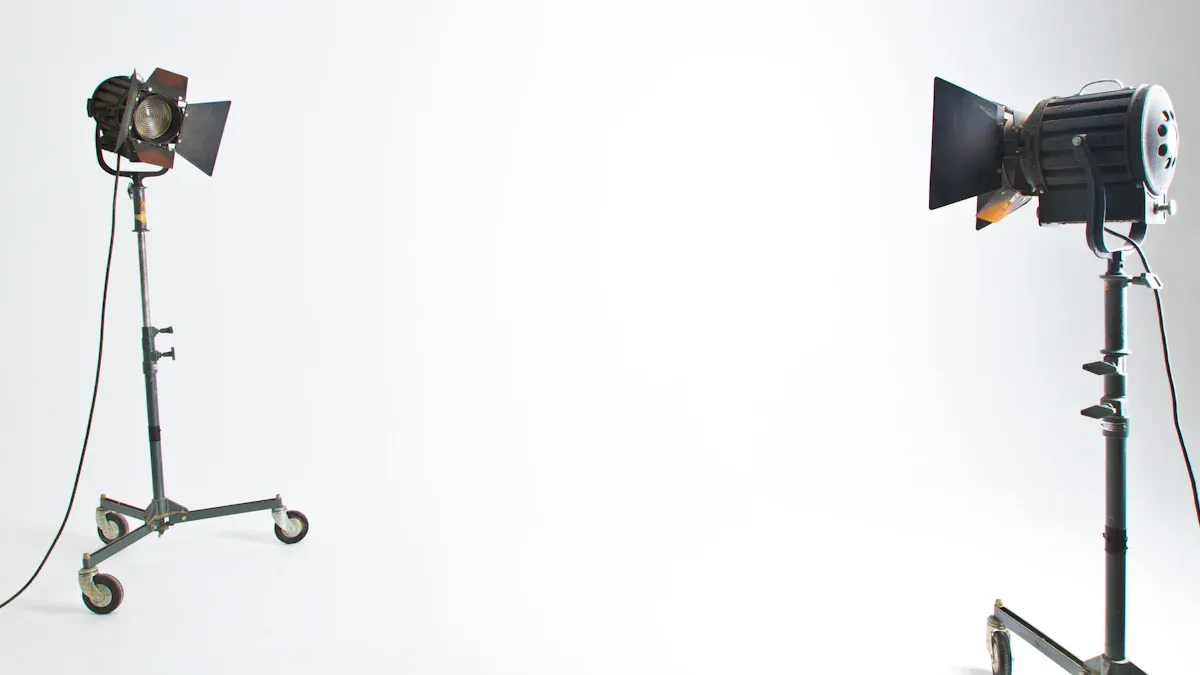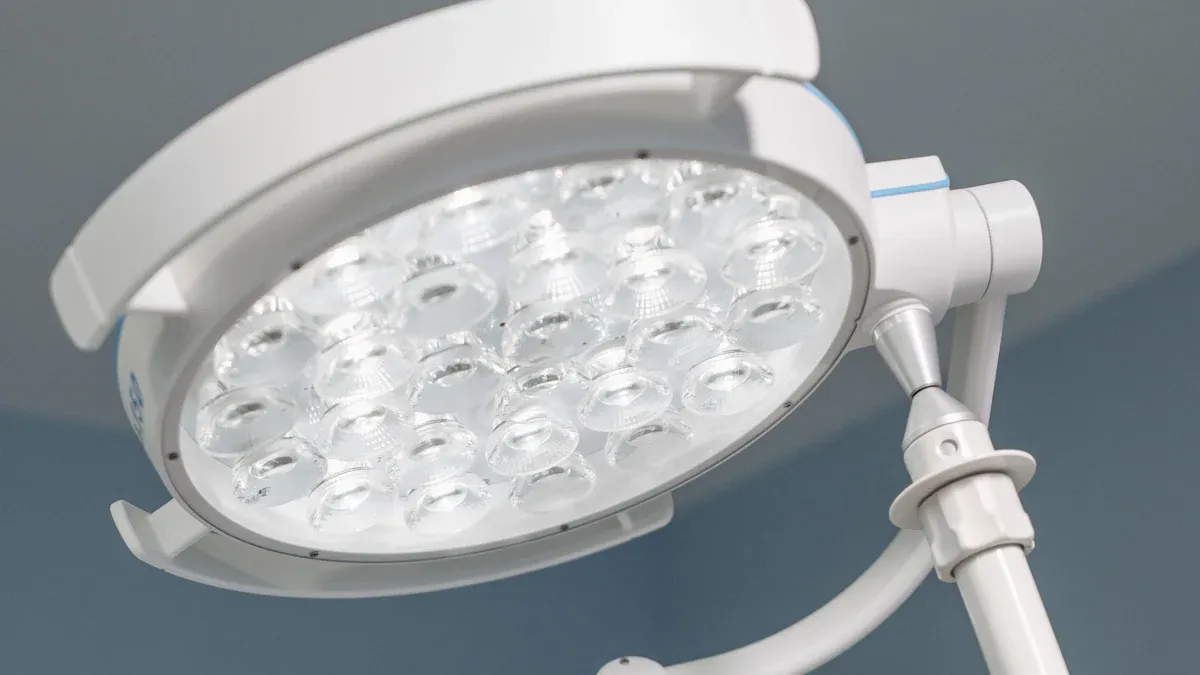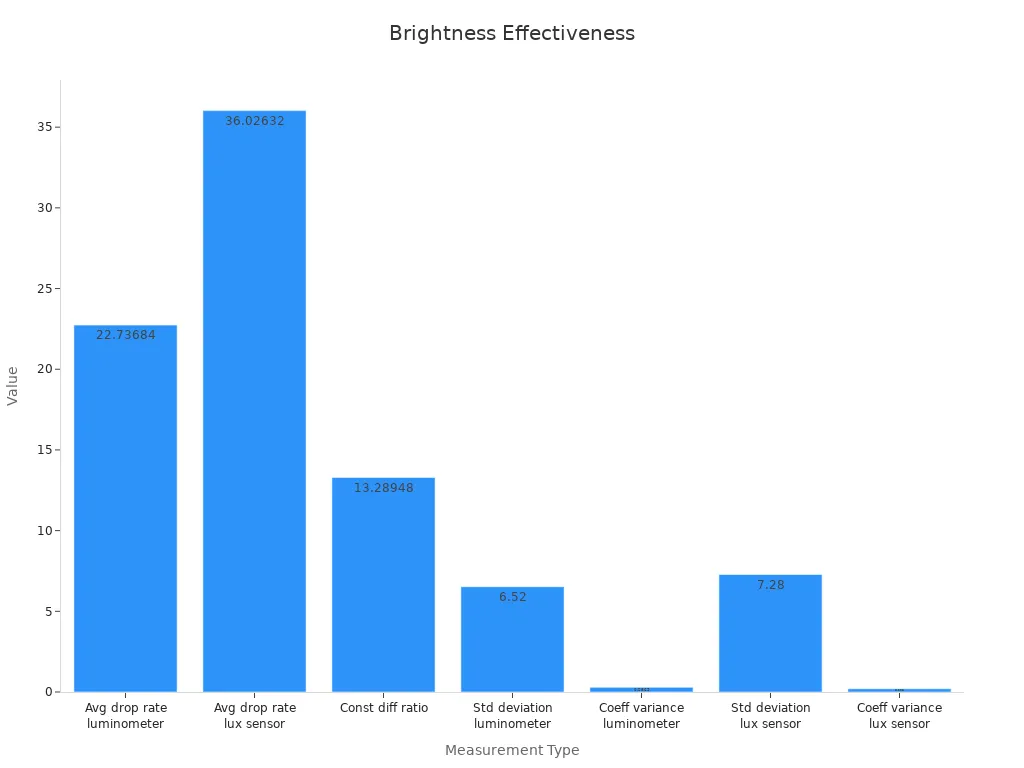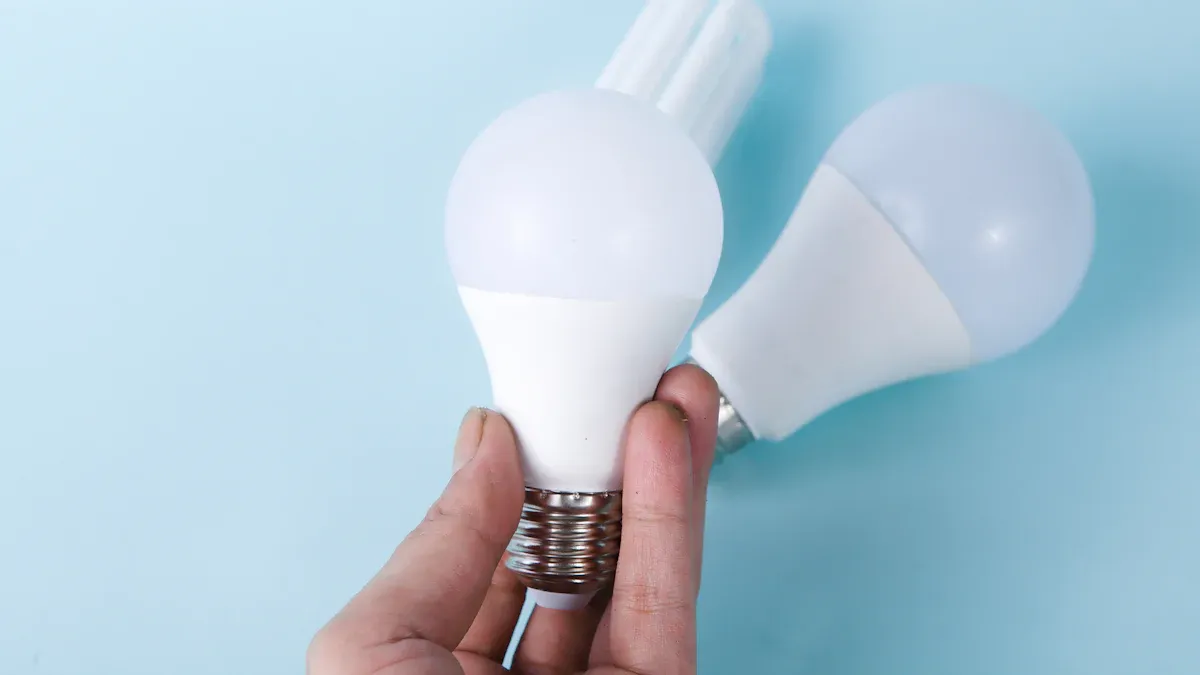Flood Lamp LED Options: Choosing the Right Brightness and Beam Angle for Your Needs

When selecting from the various flood lamp LED options, both brightness and beam angle are crucial factors to consider. Brightness indicates how effectively the LED light illuminates a space, while the beam angle determines the distance the light spreads around. Wider beam angles distribute light over shorter distances and tend to consume more energy. Research indicates that larger LED setups, such as 4×4 designs, are more energy-efficient with varying beam angles. This is essential for lighting your home, whether for safety, creating ambiance, or highlighting specific features. By choosing the right LED product, you can save energy and enhance the performance of your lights. For more information, feel free to visit our About Us page.
Key Takeaways
Brightness is measured in lumens (light) and watts (energy). Pick LEDs for strong light and lower energy bills.
Match wattage to your space size. Use 10-30 watts for small spaces and 300-1000+ watts for big areas to light them well.
Pick beam angles carefully. Narrow beams (20°-40°) light small spots, while wide beams (60°-120°) cover bigger areas, great for outdoor safety.
Think about your needs. Use bright, wide lights for outdoor safety and narrow beams to highlight yard features.
LED flood lights save energy and money. They use 75% less energy than old bulbs and last longer, making them a good choice.
Brightness Levels in LED Flood Lights

Measuring Brightness: Lumens vs. Watts
When picking LED flood lights, know the difference between lumens and watts. Lumens show how much light a bulb gives off. Watts tell you how much energy the bulb uses. LEDs are great because they make more light using less energy.
Luminous Efficiency Formula:
Luminous Efficiency = Total Lumens / Total WattsLEDs often produce over 100 lumens per watt. This is much better than older lights like halogen or HID bulbs. Using LEDs means brighter spaces and lower energy bills.
Studies say LED flood lights can cut costs by 50% or more. For example, a 100W LED light shines brighter than a 100W halogen bulb. This makes LEDs a smarter choice for saving energy.
Choosing the Right Brightness for Your Space
Pick the right brightness based on the size of your area. LED flood lights come in different wattages and lumens to fit your needs.
Coverage Area | Recommended Wattage |
|---|---|
Small Coverage Area (up to 300 sq ft) | 10-30 watts |
Medium Coverage Area (300-600 sq ft) | 50-100 watts |
Large Coverage Area (600-1,000 sq ft) | 150-300 watts |
Extra-Large Coverage Area (over 1,000 sq ft) | 300-1000+ watts |
For small places like patios, use 10-30 watt lights. Bigger areas, like driveways, need higher wattage lights for good coverage.
Brightness Recommendations for Common Applications
Different spaces need different brightness levels. Here’s a simple guide to help you pick the right LED flood light:
Lumens Range | Suitable Applications |
|---|---|
1,000 – 3,000 | Small yards, patios, and entryways |
4,000 – 8,000 | Driveways, gardens, and small parking areas |
10,000 – 20,000 | Large backyards, security lighting, commercial exteriors |
30,000+ | Stadiums, industrial spaces, and large outdoor areas |
For homes, driveways and paths usually need 1,600 to 2,400 lumens. Backyards and gardens work well with 700 to 2,000 lumens. Big spaces may need over 5,000 lumens.
Tip: Think about the beam angle when choosing brightness. A wide beam spreads light far, while a narrow beam focuses light in one spot.

Beam Angles in Flood Lamp LED Options

What Are Beam Angles?
Beam angles show how light spreads in a space. A narrow beam angle, like 20°–40°, focuses light on one spot. This works well for lighting tall ceilings or special areas. A wide beam angle, from 60°–120°, spreads light evenly over big spaces. It’s great for lighting open areas softly.
Beam Angle | Features | Best Use |
|---|---|---|
20°–40° | Focused light | Tall ceilings, accents |
60°–120° | Even, soft light | Open spaces, ambiance |
Think about what you need the light for. Use a narrow beam to highlight a statue. Use a wide beam for lighting a backyard party area.
How Beam Angles Change Light Spread
Beam angles affect how light looks and spreads. Small angles focus light in one area, making it brighter. Wide angles spread light far but make it less intense.
Here’s how different beam angles work:
Beam Angle | Area Size | Mount Height | Brightness at Ground | Best Use |
|---|---|---|---|---|
60° | Medium | 15-25 ft | 50-75 lux | Small parking lots |
75° | Large | 20-30 ft | 30-50 lux | Building exteriors |
90° | Very Large | 25-40 ft | 20-30 lux | Stadium lighting |
105° | Extra Large | 30-50 ft | 15-20 lux | Industrial yards |
120° | Maximum | 35-60 ft | 10-15 lux | Airport tarmacs |
For example, a 60° beam at 20 feet works for small parking lots. A 120° beam at 40 feet fits large industrial spaces with softer light.
Tip: Match the beam angle to the height and area size. This helps spread light evenly and saves energy.
Picking the Right Beam Angle
Choose a beam angle based on your needs. Think about the type of LED light, the area size, and how you’ll use it.
LED Type | Beam Angle |
|---|---|
LED Downlight | 30-60 |
LED High Bay Light | 60-120 |
LED Tube Light | 120-160 |
LED Flood Light | 120-150 |
LED Corn Light | 180-360 |
LED Spotlight | 15-90 |
LED Strip Light | 120 |
COB LED Strip Light | 180 |
Flood lamp LEDs often use 120°–150° beam angles. These cover large areas, perfect for outdoor security or open spaces. For focused tasks, like lighting building details, pick a narrow beam.
When choosing a beam angle, think about:
Building Size: Bigger buildings need wider beams.
Light Count: More lights can help narrow beams work better.
Ceiling Height: Tall ceilings need narrow beams for brightness.
Lighting Purpose: Different uses need specific beam angles.
By considering these points, you’ll get the best brightness and coverage for your space.
Matching Brightness and Beam Angle to Applications
Outdoor Security Lighting: High Lumens and Wide Angles
For outdoor security, use bright lights with wide beam angles. Wide beams, between 120° and 150°, spread light across big areas. These are perfect for driveways, parking lots, and building exteriors. Bright LED flood lights, with 10,000 to 20,000 lumens, help keep spaces safe and well-lit.
Motion-sensor lights are a smart choice for saving energy. They turn on only when movement is detected but still light up instantly. For example, a 120° beam with 15,000 lumens can brighten a large backyard or driveway, leaving no dark spots.
Application Type | Case Study Link |
|---|---|
Outdoor Area Lighting | Series J field lights for outside area lighting in Saint Vincent and the Grenadines |
Railway Station Lighting | Series M high mast lighting for railway station lighting in the Philippines |
Tip: Place lights high enough to cover areas without glare or shadows.
Landscape Lighting: Focused Beams for Highlights
Landscape lighting uses narrow beams to highlight specific features. A beam angle of 20°–40° works great for statues, fountains, or garden sculptures. These beams add depth and beauty without wasting light.
Use narrow beams to light up statues or fountains.
Brighten pathways or driveways for safety and visibility.
Highlight plants or garden areas for a charming look.
For example, a 30° beam can light up a tree or fountain beautifully. Narrow beams save energy by focusing light exactly where it’s needed.
Indoor Lighting: Balancing Ambiance and Functionality
Indoor lighting needs to balance brightness and comfort. The right lumens and beam angles make spaces functional and cozy. Warm white light (3000K) is relaxing for living rooms, while neutral white (4000K) works well in kitchens and bathrooms.
Color Temperature | Description | Ideal Applications |
|---|---|---|
3000K | Warm white light, feels cozy | Bedrooms, living rooms, dining rooms |
4000K | Neutral white, clear and balanced | Hallways, kitchens, bathrooms |
5000K | Bright white, helps focus | Home offices, garages, kitchens |
For workspaces like home offices, use bright white light (5000K) with a 60°–90° beam angle. This helps focus and reduces eye strain. Wider beams (120°) are better for living rooms to create a warm, inviting feel.
Note: Match the lumens to the room size. A small bedroom may need 1,500 lumens, while a big kitchen might need 3,000 or more.
Tips for Picking the Best LED Flood Light
Understand Your Space and Lighting Needs
To pick the right LED flood light, think about your space. Look at the size, purpose, and type of light you need. For outdoor security, choose bright lights with wide beam angles. For small areas or accents, use narrow beams and dimmable LEDs.
Where you place the lights matters too. Experts say to position them high to avoid glare. For example, put motion-sensor lights near doors or driveways. This improves security and saves energy. A lighting expert with 18 years of experience suggests using smart features like motion sensors for better efficiency.
Match Brightness and Beam Angle for Best Results
Getting the right brightness and beam angle is key. Narrow beams focus light, making it brighter. Wide beams spread light but make it softer. Medium angles (60–120 degrees) work well for most spaces.
Beam Angle | Brightness Effect | Best Use |
|---|---|---|
Narrow (<60°) | Focused, brighter light | Spotlights, accents |
Medium (60–120°) | Balanced light spread | General room lighting |
Wide (>120°) | Softer, spread-out light | Outdoor or ambient lighting |
Choose a beam angle based on the area and purpose. Use narrow beams for details like statues. Wide beams are better for lighting large outdoor spaces.
Tip: Check the lumens and beam angle together to get the right brightness.
Save Energy and Money Over Time
LED flood lights save energy and money in the long run. They use 75% less energy than older bulbs. This means lower electricity bills. By 2035, LED lights could save enough energy to power 92 big power plants.
High-quality LEDs last longer and need less upkeep. A contractor with 20 years of experience says spending more upfront on good lights pays off later. For outdoor use, pick lights with a high IP rating to handle weather and last longer.
Note: Dimmable LEDs let you adjust brightness, saving energy and extending their life.
By thinking about your space, balancing brightness and beam angle, and focusing on energy savings, you can find the perfect LED flood light for your needs.
Picking the right brightness and beam angle for LED flood lights helps them work better and use less energy. Wide beam angles spread light evenly in big areas. Narrow beam angles focus light on specific spots, making them stand out. Look at your space to figure out what lighting you need.
Tip: Match brightness and beam angle to the job. For security, pick bright lights with wide beams. For accents, choose narrow beams. Smart choices save energy and make lighting better.
By knowing these details, you can make your space bright, useful, and nice to look at.
FAQ
What’s the difference between lumens and watts?
Lumens show how bright a light is. Watts measure energy use. LEDs give more brightness using less energy than older bulbs. This means they save power while shining brighter.
How do I pick the right beam angle?
Think about the size of the area and its purpose. Narrow angles (20°–40°) light up small spots. Wide angles (120°+) spread light over big spaces. Match the angle to your needs for the best lighting.
Are LED flood lights good for saving energy?
Yes, they use up to 75% less energy than old bulbs. They last longer and lower electricity costs. Dimmable LEDs and motion sensors can save even more energy.
Can I use LED flood lights inside my house?
Yes! Use warm white light (3000K) for cozy rooms like living areas. Neutral white (4000K) works well in kitchens or bathrooms. Choose the right brightness and beam angle for a good balance indoors.
How do motion-sensor LED lights work?
These lights turn on when they sense movement. They save energy by staying off when no one is around. Place them near doors or driveways for safety and ease.
See Also
Selecting Optimal Brightness and Coverage for Outdoor Lighting
Guidelines for Selecting LED Lighting in Commercial Settings
Comparative Analysis of UFO, Linear, and Round High Bay Lights

